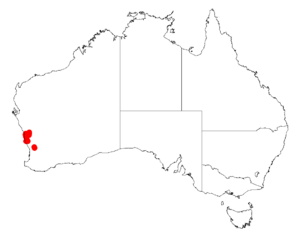Acacia fagonioides facts for kids
Quick facts for kids Acacia fagonioides |
|
|---|---|
| Scientific classification | |
| Genus: |
Acacia
|
| Species: |
fagonioides
|
 |
|
| Occurrence data from AVH | |
Acacia fagonioides is a type of shrub that belongs to the Acacia plant family. It is a special plant because it grows naturally only in a specific part of southwestern Australia. This means it is an endemic species there.
About This Plant
This spiky shrub usually grows to be about 0.2 to 0.6 metres (0.7 to 2.0 ft) tall. It has many tangled, hairy branches. These branches have sharp spines, like thorns, that grow from where the leaves meet the stem. These spines are about 8 to 18 mm (0.31 to 0.71 in) long and appear one by one at each joint.
The leaves are a blue-green to grey-green color. They have one pair of small leaf parts called pinnae, which are about 2.5 mm (0.098 in) long. Each pinna has two to four pairs of even smaller leaflets called pinnules. These pinnules are usually shaped like an oval or a narrow oval. They are 2 to 5 mm (0.079 to 0.197 in) long and 1 to 2 mm (0.039 to 0.079 in) wide.
The plant blooms with yellow flowers from June to July. Its simple flower clusters grow about halfway up an axillary spine. These clusters have round flower-heads with 13 to 25 yellow flowers.
After the flowers, smooth, hairless seed pods form. These pods are 3 to 8 cm (1.2 to 3.1 in) long and 7 to 12 mm (0.28 to 0.47 in) wide. Sometimes, they have a fine white powdery coating. The plump seeds inside are shaped like an ellipse or a circle and are 3 to 4 mm (0.12 to 0.16 in) long.
Plant Family and Similar Species
This shrub is part of a group of wattles known as the Acacia pulchella group. It looks quite similar to another plant called Acacia epacantha.
Where It Grows
Acacia fagonioides naturally grows in the Wheatbelt region of Western Australia. It is typically found in sandy soils on flat, sandy areas.
This plant has a "disjointed" distribution. This means its populations are found in separate areas, not all connected. You can find it near Toodyay, Cervantes, and Eneabba. It usually grows as part of heathlands or in forests with Corymbia calophylla trees.

